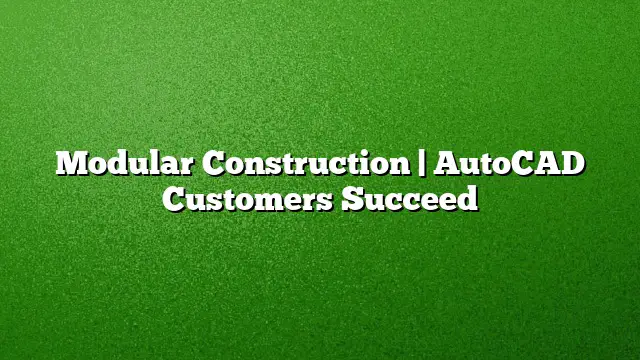Introduction to Modular Construction
Modular construction has emerged as a significant topic within the construction industry, receiving considerable media attention. However, its actual influence on practice and workflow has yet to meet early predictions. As trends evolve, innovative applications of AutoCAD by customers in this field suggest that a transformative phase may be on the horizon.
Current Challenges in Modular Construction
One of the main barriers impeding the widespread adoption of modular construction lies in the entrenched silos among various building trades. Each discipline collaborates for a brief period during a project but tends to revert to familiar processes without integrating their collective insights. This fragmentation often stymies innovation and the exploration of new methodologies.
Design professionals, especially architects, frequently express concern that modular construction mechanisms might restrict their creative freedom, leading to uniformity across new buildings. They may overlook how modern modular techniques can enhance rather than limit design possibilities.
Advantages of Modular Construction
Despite the hesitation from some quarters, modular construction offers numerous compelling benefits. Emphasizing a “building blocks” approach can lead to substantial efficiencies and innovations in the industry. For instance, using a chassis-based modular framework can create a systematic foundation, enhancing organization and reliability in construction projects.
The Role of AutoCAD in Modular Construction
Companies like ConXtech are pioneering advancements by merging architectural models with standardized building components. By employing precise, factory-welded connections attached to structural steel beams and columns, they harness the full potential of the AutoCAD 2025 platform. This approach offers increased predictability and efficiency, fostering a more streamlined construction process.
Innovations in Shipping Container Housing
While shipping containers were first patented for housing in the late 1980s, their popularity has fed into the growing trend of sustainable living. These containers possess inherent strength and are readily accessible. However, their uniform appearance as boxes can detract from aesthetic appeal. Innovative architects, such as Sean Burke, are developing creative designs that go beyond this limitation, proposing ideas that challenge traditional perceptions of container housing.
Exploring AutoCAD Customer Success Stories
AutoCAD has empowered a multitude of construction professionals to realize their visions through curated success stories. This collection showcases the motivated individuals driving exceptional projects in modular construction. Each story emphasizes innovation, creativity, and efficiency, highlighting the transformative potential of modern tools and techniques.
To explore further, the full stories can be found on Autodesk’s Line//Shape//Space, where insights from industry leaders paint a picture of the future of modular construction.
Frequently Asked Questions
1. What are the primary benefits of modular construction?
Modular construction offers increased efficiency, cost savings, faster project completion times, and enhanced sustainability. It also allows for greater flexibility in design, enabling architects to create innovative structures while minimizing waste.
2. How can AutoCAD 2025 assist in modular construction projects?
AutoCAD 2025 provides advanced tools for planning, designing, and visualizing modular projects. Its capabilities enable seamless integration of elements such as standardized components, which streamline the construction process and enhance collaboration among various stakeholders.
3. Are there any drawbacks to using shipping containers in construction?
While shipping containers are strong and sustainable options, they can often have aesthetic limitations and may require modifications to meet building codes and safety regulations. Creative design approaches are necessary to make these structures visually appealing and functional for diverse uses.

